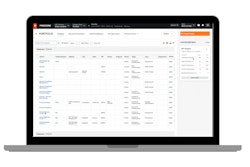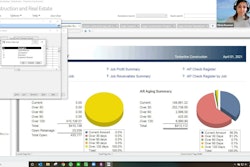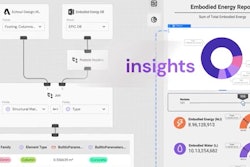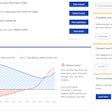
If you ask most general contractors if it is easy or hard to pay their subcontractors, not many are likely to say it is easy.
Paying a subcontractor involves a cascade of documentation, tracking documents, proof of insurance, receipts, routings and approvals. If these or other processes are constrained or fall between chairs, the cash stops. So, construction payment management can, without automation, come to consume a disproportionate amount of overhead in some contracting businesses.
Nashville-based Built Technologies is ramping up its offering for construction to help eliminate this time sink with collaborative fintech-enabled construction solutions.
But the company will be doing more than providing software functionality—they are also making financial services available to contractors right in the Built Technologies interface. This makes Built Technologies one of a growing number of companies ranging from Flashtract to Constrafor to even Procore who are embedding in-app purchase of services like finance, lending and more into construction business software. The goal is to create a unified platform that contains all of the data points and processes required to pay subcontractors, including insurance certifications and compliance documents in a collaborative environment where all stakeholders can interact.
The company, which was serving lenders before it entered the construction market in 2019 has a construction offering that encompasses payment management, lien waivers, trade partners/subcontractors and construction loans. Built Technologies has more than 600 paying contractor customers now and is prioritizing further growing its solution for and footprint among contractors so they can take the solution up market, we learned in an IronPros Deep Dive Debriefing session with Built Vice President of Product Chris Boyd.
“We are really focused on delivering the payment management solution for construction,” Boyd said. “The consistent pain point that we hear from general contractors and others in the construction industry is that when it comes to getting paid and paying people, there is a tremendous amount of tedious activity that happens manually in spreadsheets, emails, phone calls—and that includes everything from invoice generation and submission, receipt routing and approvals, and regulatory approvals before money can move. Most project management software often steers clear of payment management. We already have an aspect of that in production and will round it out with a lot of new functionality that will make it a strong option for general contractors.”
This new functionality will center to some extent on dealing with the complexity of drawing down off a loan for payment.
“We all know that debt lives in about 80 percent of the capital stacks for construction projects that are occurring across the U. S. today,” Boyd said. “So we’re about simplifying the collaboration and movement of information around all those parties. When the draw process kicks in, people are sending invoices and all of these compliance documents—seeing more people do all of that in one system is a key aspect of our five-year goal.”
Automating manual administrative processes is an okay value proposition, but Built Technologies delivers this and a few other cool benefits by leveraging the fintech side of their business.
“It is also significant to recognize that right now, a lot of the purchasing decisions made by contractors over the course of construction require them to leave the software they operate their business in and go somewhere else to do those things,” Boyd said. “We have already addressed this in the lender channel where in a lot of the software platforms that we offer, the user can actually purchase services in the application. We have also already addressed it in electronic payments, so contractors can generate and receive invoices and streamline fees and approvals and also pay all the parties involved in whatever payment mechanism they want to leverage.”
As a point solution, Built needs to work and play well with other products in a contractor’s tech stack. The company had at the time of our summer 2022 debriefing session standard integrations with Sage 100 Contractor, Sage 300 Construction and Real Estate, Procore, Quickbooks Online and Quickbooks Desktop. At that time, they were working on similar arrangements with Sage Intacct Construction and Acumatica.
“It is a combination of us building out the software and then making sure our customers can figure out—how do I get the data in and out of my ERP to reduce duplicate data entry, so we are focused on partnerships and building bidirectional interfaces,” Boyd said.
Built Technologies had just crested the 400-employee mark at the time of our debriefing session, and Boyd said they planned a nosecount of 600 by end of year. Of these employees, about a third are devoted to the construction product. At the time, construction-focused sales headcounts of 20 new-account salespeople and 40 in customer success suggest Built Technologies will have the boots on the ground to grow in construction and see to the needs of customers once they are in the fold.
Construction COI Built In
Contractors can now select software that specifically addresses certificates of insurance for construction, including venture-funded startup Billy or MyCOI. But this is a core tool within the Built Technologies offering for construction.
“Part of our philosophy is that insurance is one of a series of compliance documents—and if contractors decide to just go deep on insurance, they miss out on other documents required—W9s, proof of licensure, covid agreements, lien waivers and other notices to owner,” Boyd said.
Built Technologies may expand on their native COI functionality with either an acquisition or a partnership, adding that they are already working with third party COI tools on integrations. This would create a single version of the truth across not just COI but other compliance and finance processes Built Technologies addresses.
Built Technologies Tech Stack
Built Technologies was founded way back in 2014. when only about 22 percent of ERP software was in the cloud. This means that while the company is seasoned, it started on more of a monolithic architecture. The product set then had to absorb other solutions on both the finance and construction sides including Nativ, acquired in July of 2022 and lienwaivers.io in January of 2020. But it has evolved to a modern, multi-tenant software-as-a-service (SaaS) application with a REACT front end, Python and Node JS backend and a service-oriented architecture hosted on Amazon Web Services (AWS).
Boyd admits the architecture is heavily reliant on utilities and tools built into the AWS tech stack, including tools for failover from one availability zone to the next. In some AWS outages, the tools that handle failover have also failed, but Boyd says the company has done some work to enable the product to manage its own failover within AWS or to another cloud.
“The beauty of the architecture is that it empowers us to make a different decision in the future without redoing everything,” Boyd said. “We have actually taken some of the tech we acquired that had been on Google Cloud and migrated it over to AWS because we were happier with the service and to centralize things to a single cloud provider. We rely on the AWS tech stack for load balancers and things like that, but for a true disaster recovery, we have the control to make decisions on the timing. One reason we have this that it gives us the capability to communicate with our customers. If a failover requires that we pull a database down for a moment, we want the ability to tell customers this is going down. We need to communicate with them and make those decisions.”
Built Technologies Pricing and Market
The addressable market for Built Technologies in construction will change as the product grows, but according to Boyd, right now a general contractor with more than $10 million in revenue will be a fit.
“It is evolving as we launch more functionality,” Boyd said. “What we are finding is a lot of these products we compete with are really back-office solutions for compliance tracking and are not collaborative. What Built Technologies will do is give a contractor all the different insurance and other documents from subcontractors with one button. Other solutions are more manual.”
Built Technologies becomes attractive at the lower end of the construction middle market, but the company does have customers with revenue into the billions.
Given its focus on streamlining administration of subcontracts, contractors working on projects with more subcontractors are a better fit than contractors with fewer. This is not just because the administrative overhead of more subs is higher than fewer, but because the ability to collaboratively engages subs, lenders and other stakeholders in the same conduit through which value flows becomes even more attractive. While generals have the most intense pain point along the lines of what Built Technologies delivers, even large trade contractors can benefit and are using the application successfully.
Competitors include applications like GCPay, or the compliance components within ERP products like Sage 100 Contractor or Sage 300 Construction and Real Estate, or even Excel and manual processes. Very large general contractors may also use Oracle Textura Payment Management.
Because Built Technologies is focused on getting multiple parties to engage with the application collaboratively on projects, a per-user pricing model is not a good fit. Price is based on project revenue volume managed on the platform. When used by subcontractors, the pricing does hinge not on total project value but rather on contact value for that subcontractor.
Compared to Textura, GCPay and other options including relevant Procore functionality, Boyd said Built Technologies comes in at a lower price point even after some recent price increases on their end.
BOTTOM LINE: One fringe benefit of multi-tenant SaaS is that it facilitates the type of embedded commerce and inter-company collaboration Built Technologies is delivering as they connect contractors and lenders and owners and subs in streamlined financial transactions. Multi-tenant SaaS really makes broad application of collaborative commerce easier, but that is not the only thing cool about Built Technologies. They are also directing this commerce right at that point where project cash flow gets jammed up. In Built Technologies, we have a stable, growing company that based on recent history is more likely to acquire than be acquired. And while it is modern and open, their platform that is not as technologically advanced as it is culturally evolved. It enables project teams to interact and transact in newer, more advanced ways. And ideally, revenue from the embedded transactions could in this way subsidize the cost of modern technology for a growing percentage of contractors. That is why Built Technologies has pulled in more than $312 million in funding. The smart money seems to be seeing this as the future of construction payment management.







